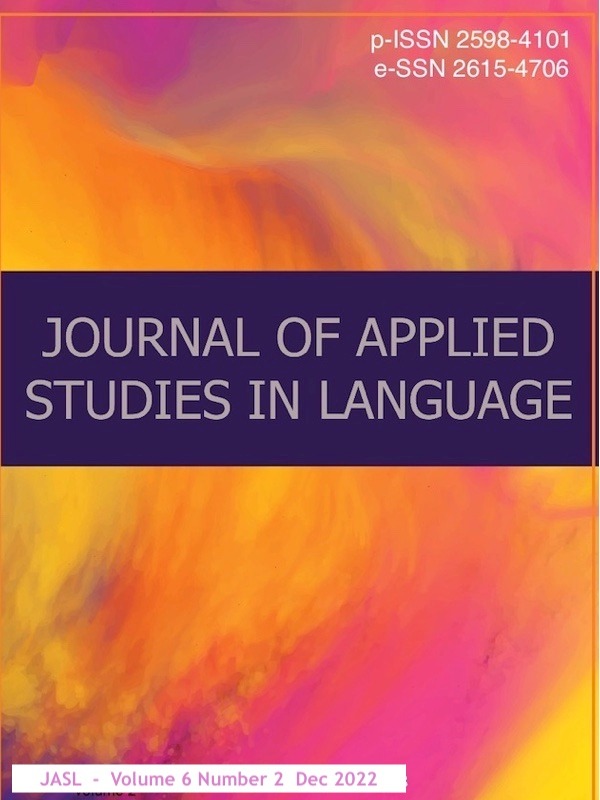Tourism language accommodation of Ubud-Bali: the virtual landscape linguistics (VLL) through google street view
Abstract
This study reveals how Virtual Landscape Linguistics (VLL) in Ubud-Bali can describe the community’s attitude when facing the global tourism industry. Data in shop signboards, information boards, and building names were collected using documentation techniques through the Google Street View application (update 2019–2021) along Raya Ubud Street, Bali, Indonesia. The selected data represents the categories of language variation and monolingual-multilingual signs. The findings show that English is used in most commercial signage, both monolingual and multilingual outdoor signs. On the other hand, the local language is seen on monolingual and multilingual outdoor signs in traditional restaurants, information boards, and vernacular building names. Through the display of English signage, tourists worldwide can see that Ubud has provided complete accommodation needs for foreign tourists. In addition, tourists can also see that the use of local languages such as Indonesian and Balinese on commercial signage and vernacular buildings shows the authentic value and culture of the local community as a tourist attraction. This study shows that VLL in the context of tourism has two functions. First, VLL helps travelers plan and organize their vacations better. Second, VLL allows stakeholders to promote their tourist areas virtually without neglecting their natural appearance.
Full text article
References
Ariani, N. M., & Artawa, K. (2021). JOURNAL OF LANGUAGE AND LINGUISTIC STUDIES Analysis of the grammatical errors of English public signs translations in Ubud , Bali , Indonesia. JOURNAL OF LANGUAGE AND LINGUISTIC STUDIES, 18(2), 899–909.
Blommaert, J. (2013). Ethnography, Superdiversity and Linguistic Landscapes. In Ethnography, Superdiversity and Linguistic Landscapes (Issue September). https://doi.org/10.21832/9781783090419
Brian McClendon. (2010). Explore the world with Street View, now on all seven continents. https://maps.googleblog.com/2010/09/explore-world-with-street-view-now-on.html
Crampton, J. W. (2001). Maps as social constructions: Power, communication and visualization. Progress in Human Geography, 25(2), 235–252. https://doi.org/10.1191/030913201678580494
Endy Marlina, Wiliarto Wirasmoyo, A. R. W. (2020). Cultural Elements As Push and Pull Factors of Cultural Tourism. Internationa Conference On Tourism Ans Entrepeneursihp, 1–13.
Google. (n.d.). Apa yang dimaksud dengan Street View? Retrieved March 14, 2022, from https://www.google.com/streetview/
Hiippala, T., Hausmann, A., Tenkanen, H., & Toivonen, T. (2019). Exploring the linguistic landscape of geotagged social media content in urban environments. Digital Scholarship in the Humanities, 34(2), 290–309. https://doi.org/10.1093/llc/fqy049
Ivkovic, D., & Lotherington, H. (2009). Multilingualism in cyberspace: Conceptualising the virtual linguistic landscape. International Journal of Multilingualism, 6(1), 17–36. https://doi.org/10.1080/14790710802582436
Khazanah, D., & Kusumaningputri, R. (2021). Unpacking Multilingualism in Tourism Peripheries in Bali: Taking a Look into Private Shop-fronts. K@Ta, 23(1), 28–37. https://doi.org/10.9744/kata.23.1.28-37
Landry, R., & Bourhis, R. Y. (1997). Linguistic landscape and ethnolinguistic vitality: An empirical study. Journal of Language and Social Psychology, 16(1), 23–49. https://doi.org/10.1177/0261927X970161002
Mulyawan, I. W. (2019). Impact of tourism on vernacular outdoor signs in Ubud, Bali, Indonesia. ISVS E-Journal, 6(1).
Mulyawan, I. W. (2020). Reading visual design of outdoor signs in Kuta (A case study of multimodal linguistic landscapes). Cogent Arts and Humanities, 7(1). https://doi.org/10.1080/23311983.2020.1748987
Mulyawan, I. W., & Ratna Erawawti, N. K. (2019). Linguistic Landscapes In Desa Kuta. E-Journal of Linguistics, 13(2), 327. https://doi.org/10.24843/e-jl.2019.v13.i02.p12
Power, M. J., Neville, P., Devereux, E., Haynes, A., & Barnes, C. (2013). “Why bother seeing the world for real?”: Google Street View and the representation of a stigmatised neighbourhood. New Media and Society, 15(7), 1022–1040. https://doi.org/10.1177/1461444812465138
Wang, Y., Yu, Q., & Fesenmaier, D. R. (2002). Defining the virtual tourist community: Implications for tourism marketing. Tourism Management, 23(4), 407–417. https://doi.org/10.1016/S0261-5177(01)00093-0
Wulansari, D. W. (2020). Kredo 3 (2020) KREDO: Jurnal Ilmiah Bahasa dan Sastra LINGUISTIK LANSKAP DI BALI: TANDA MULTILINGUAL DALAM PAPAN NAMA RUANG PUBLIK. 3(2). https://jurnal.umk.ac.id/index.php/kredo/index

